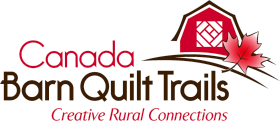Oxford County
Barn Quilt Trail Get PDF / Print this map-
Bright Beginningsmore_vertclose
[caption id="attachment_4170" align="alignleft" width="150"] Bright Beginnings[/caption] The corn, wheat and tobacco blocks illustrate Bright's agricultural roots. Farmer's fields still surround the village and the corn block also acts as a representational motif of the maize element of our First Peoples...
-
Right Hand of Friendshipmore_vertclose
The perfect block to start your tour of Oxford Country Barn Quilts is called the Right Hand of Friendship and you will find the people of this predominately rural county welcoming. The rich soil and rolling hills of the area...
-
Path Through the Woodsmore_vertclose
This block on the 90-year-old Bowman family barn symbolizes the dense forests that the early settlers of Oxford had to tame. They created roads from paths through the woods, felling thousands of trees to establish farms and villages. The County...
-
Cock’s Combmore_vertclose
A rooster and chickens were an essential part of a settler’s belongings. It seemed fitting to place this block on the 1880’s barn of Janet Justus, operator of “The Hen House Shoppe” located outside Brownsville. Named for Brinton Brown Sr.,...
-
Cross In A Crossmore_vertclose
Settlers held religious services in their homes until congregations grew large enough to build a church. Often, Methodist Circuit Ministers were the only ordained clergyman that pioneers of this area saw, and soon Methodist churches dotted the landscape. The Delmer...
-
Arrowhead Puzzlemore_vertclose
The block on the Stubbe’s Furniture Barn honours this area’s First Nations'. Prior to European settlement, Oxford County was home to many First Nations villages, one of which was located just west of here. An archaeological dig conducted in 2000 discovered an Iroquoian...
-
Roads to the Stationmore_vertclose
The coming of the railroad was an exciting event! This block is located at the Great Western Railway Station (1879-1975), which today has been repurposed to the arts-based, community involved, Station Arts Centre. The design originates from the Railroad Crossing...
-
New Water Wheelmore_vertclose
Water was an important source of power for early settlers. E.D. Tillson, son of Tillsonburg’s founder George, created a milling empire by harnessing the power of the Otter Creek. This block, located on Tillson’s Pea & Barley Mill, built in...
-
9 Patch Log Cabinmore_vertclose
This block represents the first building in Tillsonburg, a two room log cabin built by George Tillson. Settling in 1825, George and Nancy Tillson with their five children, became the fourth family in Dereham Township. Born that same year, their...
-
Churn Dashmore_vertclose
The Churn was an important household item for the early settler. Churns were used into the early 1900’s on farms, like this century family dairy farm, that now has the fourth generation of Holstein breeders living and working on it....
-
Envelope Motifmore_vertclose
In 1905, Springford's George Wilcox began lobbying politicians to provide mail delivery to rural Canada since urban residents already had that convenience. By June 1911, the first mail was delivered to the farmers in South Norwich Township. Due to George's...
-
Church Windowmore_vertclose
As early as 1829, free blacks made their way to the Otterville area and by 1840, their settlement was significant enough for a school to be built. By 1856, they constructed their church on this site. Blacks settled here near...
-
Grist Millmore_vertclose
Recognized as an ideal mill site, with the building of Earl and Avery’s Mill in 1807, Otterville became one of the area’s early settlements. Quakers or members of the Religious Society of Friends were also attracted here, as were free...
-
Weathervanemore_vertclose
“Reading the signs” to forecast the weather was a talent many settlers developed. To assist, early barns were decorated with a weathervane and lightning rods. This farm was settled by Job Church. Being a butcher by trade, Job was one...
-
Tobacco Roadmore_vertclose
This area’s cultural diversity developed most of its roots from European and American settlers who were attracted to growing the rich tobacco crop. 1928 saw the first crop grown in the township; 1930, on this farm. Since 1943, this has...
-
Corn & Beansmore_vertclose
Cowric Farms is owned and operated by four brothers and their families. The brothers are descendants of Samuel Cornwell, an early settler in Norwich Township. The Corn and Beans pattern represents the rich heritage of crops grown in Oxford County,...
-
The Wagon Wheelmore_vertclose
The Norwich & District Historical Society is comprised of a museum and archives. Buildings on site include the 1889 Quaker Meeting House and the 1811 Peter Lossing Saltbox house. The Wagon Wheel represents the journey of early Quakers settlers to...
-
Friendship Blockmore_vertclose
This farm, presently owned by Hans and Ursula Habeggar, was first occupied by Joseph Throckmorton and his wife, Adeline Delong whose father, Peter Delong, accompanied Peter Lossing from Dutchess County, New York, in 1810. The Friendship Quilt symbolizes the fact...
-
The Dutchman’s Puzzlemore_vertclose
The ‘Dutchman’s Puzzle’ represents the integral role of Dutch immigration to Oxford County, which began as early as 1946. Henry Couwenberg emigrated to Canada from the Netherlands in 1956. In 1965 he and his wife Kay established Couwenholm Farms and...
-
Farmer’s Daughtermore_vertclose
This block pays homage to the women of pioneer families who worked alongside the men to settle Oxford County. Hard work in both the field and the home created strong women whose influence can still be felt throughout the County...
-
Wagon Tracksmore_vertclose
Roads were the lifeline of pioneer settlement. Fittingly “Wagon Tracks” is located on the historic Stage Road, Southwestern Ontario’s first road. As early as 1829, this important road saw up to 36 coaches and express riders daily. It was also...
-
Grandmother’s Lovemore_vertclose
The quilt block is called "Grandmother's Love" it is an original design based on two quilts that belong to the family. The 2 quilt blocks represent quilts that were made by Evelyn Lazenby - Bob's mother - for her granddaughters...
